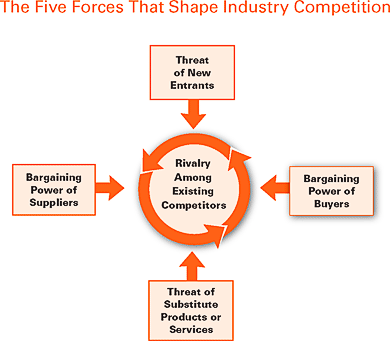Continuing on from my previous post I present you with another ‘traditional marketing’ gem : Porter’s 5 forces. It wasn’t until my final year at university that Mr Porter and I made peace and I decided that it was time I tried to understand his theory. Up until that point in my life I had ignored the existence of this 30 year old marketing model in the hope that I would never need it, but here I am – voluntarily writing about it!
Mr Porter is probably grinning, revenge! I imagine that grin to look a little bit like this:
Disclaimer: This is not the real Mr Porter; I don’t know what he looks like!
What are these forces you speak of?
Mr Porter, back in 1979 identified five factors he believed that when analysed could help a company get a better understanding of the structure of the industry they’re in. This understanding would help them to stake out a position that is more profitable and less vulnerable to attack. These five forces are:
– Bargaining power of Suppliers
– Bargaining power of Buyers
– Competitive Rivalry
– Threat of Substitution
– Threat of New Entry
It looks something like this:
What makes Porter special?
Porter’s five forces model is great for analysing the market attractiveness and very useful for understanding where the power lies. Whether you’re thinking of getting into a new market or you want to understand the strength of your current position, the 5 forces will come in handy.
This in-depth understanding of the market has quite a few advantages:
– Taking fair advantage of a situation of strength
– Avoiding taking the wrong steps
– Improving on a situation of weakness
– Identifying attractive potential markets
The 5 forces model is particularly helpful in the planning process and for strategists. A common mistake that managers or business owners make is to underestimate their competitors or count their ‘direct competitors’ as their ‘only competitor’. However, that narrowed look could be very threatening – by analysing the: customers, suppliers, potential new-comers, and substitute products you’ll be looking in every corner to identify your competitors.
Would you agree for example that a restaurant’s only competitors are other restaurants?
The answer is obviously no. Any business that could be a substitute could be a competitor. Takeaways would be another direct competitor but even diets would be a substitute because they will make the customer substitute the restaurant for the diet. Saving up for a house, car, and holiday could also be a substitute, as well as places in the entertainment industry that offer food e.g. bowling alleys and cinemas.
All of these areas need to be analysed in order for that restaurant to ensure they’re planning adequately and to avoid them becoming a threat. This could be through various promotional activities and special offers.
Understanding the Forces
Bargaining power of Suppliers: In this force you’re assessing the power the supplier has over your business. If there are many suppliers, the power of the supplier would be low but if there aren’t enough suppliers the power of the supplier would be high. If the supplier has a lot of power over you they’ll have high bargaining power over their prices and you would have to agree on them but if you have alternatives suppliers, you’ll have the option of finding a better deal.
Bargaining power of Buyers: This will be assessing how important every single customer is to you and your business. If you have few customers, you’ll be more dependent on them – often they’ll be able to dictate the terms of the business. If you have a lot of customers you would be more in control and they won’t be able to dictate the terms. You also need to consider how easy or difficult it is for the customers to switch from your products and services to that of the competitors.
Switching in the mobile phone industry is very easy which is why providers are increasing the terms of the contracts. Initially began as a 12 month mobile phone contract increased to 18, and now to 24 so that customers won’t be able to switch as easily.
Competitive Rivalry: How fierce is the competition in the industry and how competitive are you? Do you lead or follow? Are there leaders in your industry? What do the competitors offer? If they don’t offer a good deal, can you offer one to have a stronger place?
Threat of Substitution: This is the factor that’ll enable you to look at your competitors from a different angle. Who out there can be a substitute for what you’re doing? Going back to the restaurant example – avoid just looking at your direct competitors. You need to be as broad as you can and analyse industries that aren’t directly related to you but could still be a substitute for what you’re offering.
Threat of New Entry: Your power in the industry will be directly affected by how easy it is for other people to enter your market too. Is it expensive or cheap to enter your market? Can you do anything to make it harder for potential competition to enter e.g. patents, licenses? The stronger and more durable the barriers are to entry, the longer you can maintain your position in the market. The same goes if you’re researching a potential market to enter into – if there are strong barriers to entry it might not be worth it!
Porter’s 5 forces is a simple yet effective tool that will definitely help you when planning and implementing strategies. My next post will be about another traditional marketing gem. I hope you’ve found this useful but if you haven’t here is something that’ll definitely be of some use!
Looking for a digital marketing agency that can help you improve your SEO, create engaging content, and offer full web development and design services? Get in touch with us, we’re always happy to have a chat!






